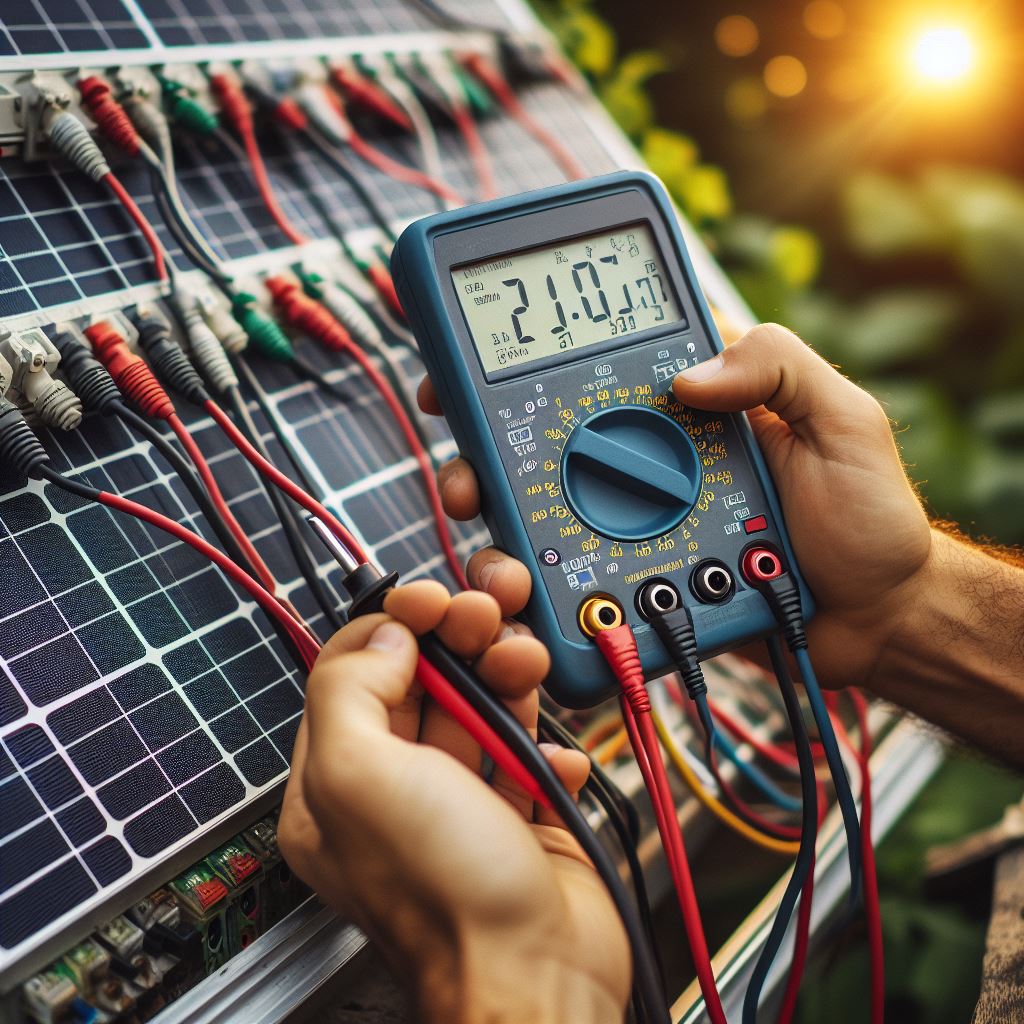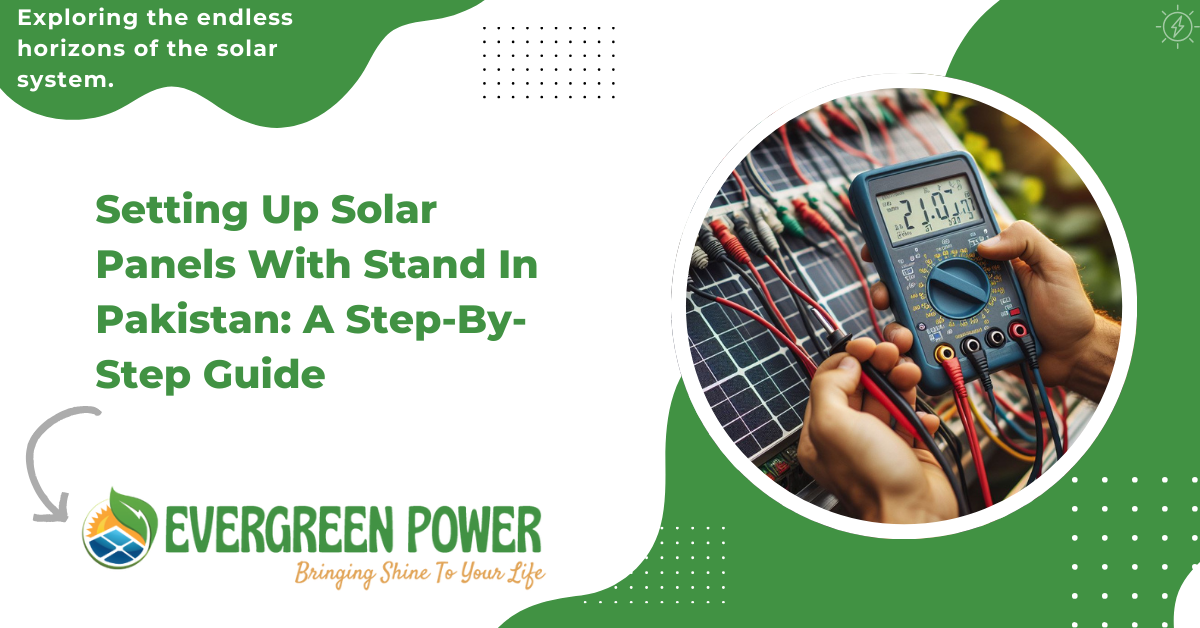With the rising costs of electricity and a growing concern for the environment, more people in Pakistan are turning to solar power as a sustainable and cost-effective alternative. Setting up solar panels with Stand is an excellent way to harness solar energy efficiently. In this comprehensive guide, we will walk you through the process of setting up solar panels with a stand in Pakistan, step by step.
Understanding Your Energy Needs
Before you begin setting up your solar panels, it’s essential to understand your energy requirements. Calculate your average daily electricity consumption to determine the size of the solar power system you need. This will help you select the right equipment and ensure that your solar panels with Stand can meet your energy needs effectively.
To calculate your energy needs, you can start by examining your electricity bills from the past year. Look for your monthly electricity usage in kilowatt-hours (kWh). Add up the total kWh for the year and divide by 365 to get your average daily electricity consumption.
For example, if your total electricity usage for the year is 5,475 kWh, your average daily consumption would be:
| Average daily consumption | 365 days |
Once you have determined your average daily electricity consumption, you can use this information to size your solar panel system.
Identifying the Perfect Location
Choosing the right location for your solar panels with stand stais crucial for maximizing energy production. Look for a location that receives ample sunlight throughout the day, preferably free from any shading. South-facing roofs or open areas are usually ideal for solar panel installations.
In Pakistan, the optimal orientation for solar panels is south-facing. This allows the panels to capture the maximum amount of sunlight throughout the day. Additionally, you’ll want to ensure that the location is free from any obstructions that could cast shadows on the solar panels, such as trees, buildings, or other structures.

Checking Local Regulations and Permits
Before installing your solar panels, make sure to check the local regulations and obtain any necessary permits. Different regions may have specific requirements for solar panel installations, so it’s essential to ensure that you are compliant with local laws and regulations.
In Pakistan, the process for obtaining permits and approvals for solar panel installations may vary depending on your location. In general, you may need to obtain permits from your local municipal authority or utility company. These permits typically include a structural permit for the installation of the solar panels with stand and an electrical permit for the connection to the grid.
Building Your Solar Powerhouse – Choosing the Right Equipment
Selecting the Right Solar Panels
When choosing solar panels with stand for your system, consider factors such as efficiency, durability, and warranty. Monocrystalline panels are often preferred for their higher efficiency, while polycrystalline panels offer a more budget-friendly option.
Monocrystalline solar panels are made from a single crystal structure, which allows them to be more efficient in converting sunlight into electricity. They are typically more expensive than polycrystalline panels but offer better performance, especially in low-light conditions.
Polycrystalline solar panels with stand are made from multiple silicon crystals, making them less efficient than monocrystalline panels but more affordable. They are a good option if you have limited space or budget constraints.
Choosing the Perfect Mounting Stand
The mounting stand is a crucial component of your solar panel system, as it provides support and allows you to adjust the angle of the panels for maximum sun exposure. Choose a mounting stand that is sturdy, weather-resistant, and designed to withstand the elements.
There are several types of mounting stands available, including ground mounts, roof mounts, and pole mounts. The type of mounting stand you choose will depend on factors such as your location, available space, and budget.
Ground mounts are installed on the ground and are ideal for locations where you have plenty of space and want to maximize sun exposure. Roof mounts are installed on the roof of your home and are a good option if you have limited space or want to keep your solar panels with stand out of sight. Pole mounts are installed on a pole and can be adjusted to optimize sun exposure throughout the day.
Selecting an Appropriate Inverter
The inverter converts the DC power generated by your solar panels with stand into AC power that can be used to power your home. Choose an inverter that is compatible with your solar panel system and meets your energy needs.
There are three main types of inverters: string inverters, microinverters, and power optimizers. String inverters are the most common type and are suitable for most residential solar panel systems. Microinverters are installed on each individual solar panel and are ideal for systems with shading issues or varying panel orientations. Power optimizers are installed on each solar panel and work with a central inverter to optimize energy production.
Installing the Solar Panel Stand
Preparation and Safety
Before installing the solar panel stand, make sure to prepare the installation site and take necessary safety precautions. Clear the area of any debris or obstacles, and ensure that you have the necessary safety equipment, such as gloves and safety goggles.
Start by marking the location of the stand on the ground using stakes or markers. Then, use a shovel or auger to dig holes for the stand’s support posts. The depth of the holes will depend on the size and type of stand you are installing, so be sure to check the manufacturer’s instructions.
Assembling the Stand Structure
Follow the manufacturer’s instructions to assemble the stand structure. Most solar panel stands come with pre-drilled holes and detailed assembly instructions, making the process relatively straightforward.
Start by attaching the support posts to the base of the stand using the provided hardware. Then, attach the cross braces and support beams according to the manufacturer’s specifications. Make sure that all connections are secure and that the stand is level and square.
Mounting the Solar Panels
Attaching Panels to the Stand
Carefully attach the solar panels to the mounting stand, following the manufacturer’s instructions. Most solar panels come with mounting brackets or rails that attach directly to the stand structure.
Start by positioning the first panel on the stand and securing it in place using the provided hardware. Then, attach the remaining panels, making sure that they are evenly spaced and properly aligned.
Adjusting Panel Angles for Optimum Performance
Adjust the angle of the solar panels to optimize their exposure to the sun throughout the day. In Pakistan, the optimal angle for solar panels with stand in Pakistan is typically equal to the latitude of your location, with adjustments made for seasonal variations.
To determine the optimal angle for your solar panels, you can use an online solar angle calculator or consult with a solar professional. Once you have determined the optimal angle, adjust the tilt of the panels using the mounting stand’s tilt mechanism.
Ensuring Proper Wiring and Connections
Connect the solar panels to the inverter and ensure that all wiring is properly insulated and secure. Test the system to ensure that it is functioning correctly before connecting it to your home’s electrical system.
Start by connecting the wires from the solar panels to the wires from the inverter according to the manufacturer’s instructions. Make sure that all connections are tight and properly insulated to prevent any electrical hazards.
Testing and Maintenance
Conducting System Checks
Regularly monitor your solar panel system to ensure that it is operating efficiently. Check for any signs of damage or malfunction and address any issues promptly.
Inspect the solar panels with stand regularly for signs of damage, such as cracks, chips, or discoloration. Check the wiring and connections for any signs of wear or corrosion, and make any necessary repairs or replacements.
Monitoring Energy Production
Track the energy production of your solar panel system to ensure that it is meeting your energy needs. Many solar inverters come with monitoring software that allows you to track energy production in real-time.

Monitor your solar panel system’s energy production regularly to ensure that it is performing as expected. Keep track of your energy production over time and compare it to your energy consumption to ensure that your system is meeting your needs.
Performing Regular Maintenance for Optimal Efficiency
Perform routine maintenance on your solar panel system to keep it operating at peak efficiency. This may include cleaning the panels, inspecting wiring and connections, and checking for any signs of damage.
Clean the solar panels regularly to remove dirt, dust, and debris that can reduce their efficiency. Use a soft brush or sponge and a mild detergent to clean the panels, and rinse them thoroughly with water.
Inspect the wiring and connections regularly to ensure that they are secure and properly insulated. Look for any signs of wear or corrosion and make any necessary repairs or replacements.
Enjoying the Rewards – Reap the Benefits of Solar Power
Reduced Electricity Bills
One of the primary benefits of solar power is the potential for significant cost savings on your electricity bills. By generating your own electricity from the sun, you can reduce or even eliminate your reliance on the grid.
With solar power, you can generate your own electricity from the sun and reduce your reliance on expensive grid power. This can lead to significant cost savings on your electricity bills over time, allowing you to recoup your initial investment and enjoy long-term savings on your energy costs.
Environmental Responsibility
Solar power is a clean and renewable source of energy that produces no harmful emissions or pollution. By switching to solar power, you can reduce your carbon footprint and help protect the environment for future generations.
Unlike fossil fuels, which produce harmful greenhouse gas emissions when burned, solar power produces no emissions or pollution. By generating your own electricity from the sun, you can reduce your impact on the environment and help combat climate change.
Additional Considerations
Financing Options
There are various financing options available for solar panel installations in Islamabad, including loans, leasing, and government incentives. Explore your options to find the best solution for your budget and needs.
Many banks and financial institutions offer loans and financing options specifically for solar panel installations. These loans typically have low-interest rates and flexible repayment terms, making them an affordable option for homeowners.
Regulatory Considerations
Before installing your solar panels, make sure to familiarize yourself with any local regulations and obtain any necessary permits. This may include zoning restrictions, building permits, and electrical permits.
In Pakistan, the process for obtaining permits and approvals for solar panel installations may vary depending on your location. In general, you will need to obtain permits from your local municipal authority or utility company.
Choosing a Reputable Solar Installer
When installing solar panels, it’s essential to work with a reputable and experienced installer. Look for a company with a proven track record of quality installations and excellent customer service.
Before choosing a solar installer, be sure to research their credentials and experience. Look for reviews and testimonials from previous customers, and ask for references to verify their work.
Safety Precautions
When installing solar panels, always prioritize safety. Make sure to follow all safety guidelines and use the proper safety equipment to prevent accidents and injuries.
Before starting any work on your solar panel system, be sure to familiarize yourself with all safety procedures and guidelines. Wear appropriate safety gear, such as gloves, safety goggles, and a hard hat, and use caution when working at heights or with electrical equipment.
FAQ about Solar Panels with Stand
How do I install solar panels step by step?
Installing solar panels with stand involves several steps:
Understanding energy needs and assessing the location for optimum sunlight exposure.
Obtaining necessary permits and approvals.
Choosing the right solar panels, mounting stand, and inverter.
Installing the solar panel stand securely.
Mounting the solar panels with stand.
Ensuring proper wiring and connections.
Testing the system for functionality and efficiency.
Regular maintenance and monitoring.
What is needed for a stand-alone solar system?
A: A stand-alone solar system, also known as an off-grid system, requires several components:
Solar panels to capture sunlight.
Charge controller to regulate battery charging.
Deep-cycle batteries to store excess energy.
Inverter to convert DC power from batteries to AC for use in appliances.
Wiring and cables for connections.
Mounting structure for solar panels.
Backup generator or alternative energy source for extended periods of low sunlight.
How to install solar panels step by step?
Installing solar panels involves several steps:
Understanding energy needs and assessing the location for optimum sunlight exposure.
Obtaining necessary permits and approvals.
Choosing the right solar panels, mounting stand, and inverter.
Installing the solar panel stand securely.
Mounting the solar panels onto the stand.
Ensuring proper wiring and connections.
Testing the system for functionality and efficiency.
Regular maintenance and monitoring.
What is needed for a stand-alone solar system?
A stand-alone solar system, also known as an off-grid system, requires several components:
Solar panels to capture sunlight.
Charge controller to regulate battery charging.
Deep-cycle batteries to store excess energy.
Inverter to convert DC power from batteries to AC for use in appliances.
Wiring and cables for connections.
Mounting structure for solar panels.
Backup generator or alternative energy source for extended periods of low sunlight.
Can solar panels work at night?
Solar panels cannot generate electricity at night since they require sunlight to produce power. However, solar panels can still contribute to energy production during the day, and excess energy can be stored in batteries for use at night or during periods of low sunlight.
Do solar panels work without direct sunlight?
A: Solar panels can still generate electricity on cloudy days or in indirect sunlight, although their efficiency may be reduced compared to direct sunlight. Modern solar panels are designed to capture diffuse sunlight and can produce electricity even under cloudy conditions, albeit at a lower rate than under direct sunlight.
Conclusion
Setting up solar panels with a stand in Pakistan is a smart and sustainable choice for powering your home. By following this step-by-step guide, you can harness the power of the sun to generate clean, renewable energy and enjoy significant cost savings on your electricity bills. With the right equipment, careful planning, and regular maintenance, your solar panel system can provide you with reliable, affordable, and environmentally friendly energy for years to come.

